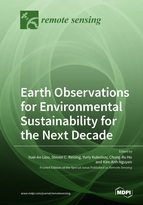Earth Observations for Environmental Sustainability for the Next Decade
A special issue of Remote Sensing (ISSN 2072-4292). This special issue belongs to the section "Environmental Remote Sensing".
Deadline for manuscript submissions: closed (31 March 2020) | Viewed by 82375
Special Issue Editors
2. Taiwan Group on Earth Observations, Hsinchu, Taiwan
Interests: remote sensing; atmospheric science; environmental monitoring; disaster analysis
Special Issues, Collections and Topics in MDPI journals
Interests: microwave remote sensing of the earth's atmosphere and oceans; earth science measurements from nanosatellites and CubeSats; radiometer and radar systems from GHz to THz frequencies; low-noise monolithic microwave IC design and packaging
Special Issues, Collections and Topics in MDPI journals
Interests: climatology of severe weather phenomena (tropical cyclones, thunderstorms and lightning); climate monitoring and prediction; satellite remote sensing for climate monitoring
Special Issues, Collections and Topics in MDPI journals
Interests: remote sensing; physical oceanography; global change; satellite oceanography
Special Issues, Collections and Topics in MDPI journals
2. Institute of Geography, Vietnam Academy of Science and Technology, 18 Hoang Quoc Viet Rd., Cau Giay, Hanoi, Vietnam
Interests: vulnerability assessment; environmental monitoring; land use/land cover change; urban greenspace; urban heat island
Special Issues, Collections and Topics in MDPI journals
Special Issue Information
Dear Colleagues,
Evidence of the rapid degradation of the Earth's natural environment is getting stronger each year, and sustaining our planet has become the greatest concern faced by humanity. In 17 Sustainable Development Goals (SDGs) in The 2030 Agenda for Sustainable Development, earth observations have been identified as major contributors to nine of them: 2 (Zero Hunger), 3 (Good Health and Well-being), 6 (Clean Water and Sanitation), 7 (Affordable and Clean Energy), 11 (Sustainable Cities and Communities), 12 (Sustainable Consumption and Production), 13 (Climate Action), 14 (Life Below Water) and 15 (Life on Land). Achieving the SDGs by turning knowledge into a significant contribution is the critical challenge for research scientists and other subject matter experts throughout the world.
This Special Issue aims to gather original viewpoints and bring up discussions concerning various areas of science of earth observations and environmental health. Innovative techniques/approaches are encouraged to be introduced to foster applications in contemporary practice, along with challenging papers related to the following topics, to be submitted to this Special Issue:
- Disasters;
- Health;
- Energy;
- Climate;
- Water;
- Weather;
- Ecosystems;
- Agriculture/forestry/fishery;
- Biodiversity;
- Industry and policy.
Dr. Yuei-An Liou
Dr. Steven C. Reising
Dr. Yuriy Kuleshov
Dr. Chung-Ru Ho
Dr. Kim-Anh Nguyen
Guest Editors
Manuscript Submission Information
Manuscripts should be submitted online at www.mdpi.com by registering and logging in to this website. Once you are registered, click here to go to the submission form. Manuscripts can be submitted until the deadline. All submissions that pass pre-check are peer-reviewed. Accepted papers will be published continuously in the journal (as soon as accepted) and will be listed together on the special issue website. Research articles, review articles as well as short communications are invited. For planned papers, a title and short abstract (about 100 words) can be sent to the Editorial Office for announcement on this website.
Submitted manuscripts should not have been published previously, nor be under consideration for publication elsewhere (except conference proceedings papers). All manuscripts are thoroughly refereed through a single-blind peer-review process. A guide for authors and other relevant information for submission of manuscripts is available on the Instructions for Authors page. Remote Sensing is an international peer-reviewed open access semimonthly journal published by MDPI.
Please visit the Instructions for Authors page before submitting a manuscript. The Article Processing Charge (APC) for publication in this open access journal is 2700 CHF (Swiss Francs). Submitted papers should be well formatted and use good English. Authors may use MDPI's English editing service prior to publication or during author revisions.









